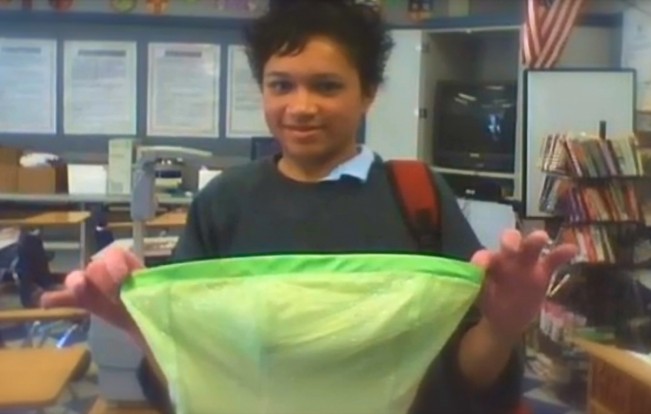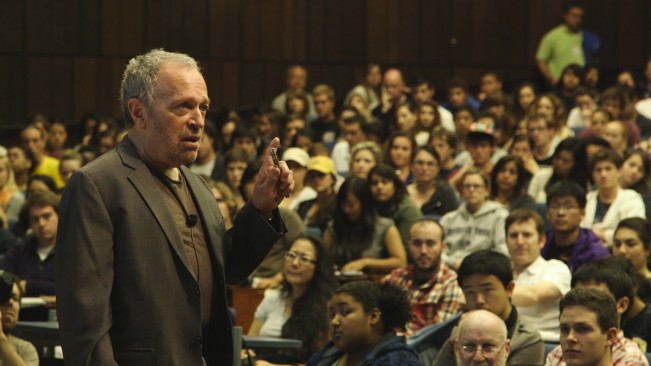By Jake Howell jake.howell@utoronto.ca
Sundance Review: Doc Wrap-Up
Valentine Road
If you somehow needed another reminder that intolerance and bigotry still exist in modern society, Marta Cunningham’s Valentine Road delivers: the HBO-produced documentary serves up a heartbreaking portrait of a small-town community that engages before it enrages. That’s because the film feels like two separate documentaries. The first half, wisely, is used as exposition to flesh out the depressing details of February 12, 2008, where in Oxnard, California (approx. an hour outside of Los Angeles), student Brandon McInerney shot fellow eighth-grade classmate Larry King twice in the back of the head. The murder is a relatively black-and-white case: a kid is dead and another is behind bars.
 There are motives behind McInerney’s actions, but of course, none of them are justified. (Killing rarely is.) Thankfully, Valentine Road‘s beginning is dedicated to exploring the troubled personal lives of both Larry and Brandon, giving us a broader sense of what happened (and the larger issues at play). Openly-gay Larry grew up in a foster home; Brandon’s parents battled with addictions while his violent father hurt the ones he loved.
There are motives behind McInerney’s actions, but of course, none of them are justified. (Killing rarely is.) Thankfully, Valentine Road‘s beginning is dedicated to exploring the troubled personal lives of both Larry and Brandon, giving us a broader sense of what happened (and the larger issues at play). Openly-gay Larry grew up in a foster home; Brandon’s parents battled with addictions while his violent father hurt the ones he loved.
The film is so interesting because of the external factors that led to Larry’s senseless murder. Valentine Road is at once a documentary about a specific slaying, but it is also an examination of gun control, intolerance, and the overall situation of mental health in the United States. Brandon shouldn’t have had access to the gun he used to kill Larry, and Larry’s undermining of Brandon’s masculinity (Larry had flirted teasingly with him on the playground) does not—nor should it ever—justify murder. The whole event is a black stain on an otherwise innocuous town (and given its proximity to Los Angeles, a place you’d expect to be a liberal community).
Valentine‘s latter half is a showcase of nutjobs who find merit behind Brandon’s actions. Heroically, equipped with a neutral point of view that refrains from interruption, Cunningham tracks: an intolerant teacher at the school, the slimy defense lawyers who each get “Save Brandon tattoos”, and the bigoted jury who try to get into the mindset of McInerney, a kid who is violent in custody and pens pictures of swastikas in his free time. (“They’re just doodles!” a jury member exclaims. “I used to doodle all the time!”)
Case in point: the “Free Brandon McInerney” Facebook page, which at the time of writing has 55 “likes, writes this as their manifesto: “Help save Brandon McInerney, a poor, innocent child who is being persecuted by California authorities for standing against the homosexual agenda.”
The opinions expressed here are sickening, to say the least, and audiences will sigh in exasperation and wring their hands when bigots in the film try to defend or justify what is a case-closed murder. A boy is dead: teasing, flirting, or otherwise dressing up like a girl has no actual relevance when it comes to his murder. The victim blaming here is infuriating, and much respect goes to Cunningham for remaining distant and hands-off during filming.
Dirty Wars
Not convinced by Zero Dark Thirty‘s portrayal of events, I checked out Richard Rowley’s Dirty Wars, the Jeremy Scahill-led documentary that uncovers the covert operations performed by the United States military in Middle-Eastern territories that have not openly declared war.
Scahill, The Nation magazine’s National Security Correspondent (and author of notable book Blackwater), has spent much of his career as a journalist in tumultuous areas of the world. With Dirty Wars, Scahill begins the film looking into a mysterious nighttime raid of an innocent family in Afghanistan, finding that the rabbit hole goes much deeper: the raid was carried out, for no clear reason, by military organization JSOC (the Joint Special Operations Command). Scahill deduces that JSOC has been given the authority to eliminate targets and individuals without a trace, leaving the United States military (and the Obama administration) in a very sketchy ethical dilemma.
JSOC becomes Scahill’s focus, moving from region to region and picking up the breadcrumbs left by the shadowy actions of the Command. Scahill’s investigation is naturally very critical of what has been accomplished throughout these “dirty wars,” and the film excels as a saddening reality check.
Rowley’s documentary had the hallmarks of being something truly incendiary, but much of the film’s impact is lessened by Scahill’s constant lamentations and poetic narration. We understand these events to be troubling, but Rowley spends far too long lingering on the way life has changed for Scahill and the way these wars have had a negative impact on his mood. It is a film that is dirtied by its own lead, despite Scahill being definitively insightful and knowledgeable about the regions. The man is a brilliant journalist—there is no doubt about that—but the documentary sags when it should ignite.
Of course, the film is informative as it digs through the muddy footprints of armed combat. It’s just that before I join the cause and condemn the parties involved in Scahill’s investigation, I hesitate: I trust mistakes have been made and plenty of details have been redacted, but there is much to read about that could explain some of the “known unknowns” at play here.
Blackfish
One of the must-see documentaries to come out of Sundance this year is Blackfish, which sold for major numbers to CNN and Magnolia Pictures after its Park City premiere. Eminently watchable and overtly shocking, Gabriela Cowperthwaite’s film dives into the murky deeps of keeping orcas in captivity, singling out SeaWorld and its spectacles as both dangerous and unethical for all parties involved.
Cowperthwaite seeks out former SeaWorld employees to tell their tales of ignorance and naivety during their time spent training killer whales. Going into detail of the various horrors that each whale has to put up with on a lifetime basis, each subject also mourns the tragic death of Dawn Brancheau, the talented SeaWorld trainer who lost her life in early 2010. Brancheau’s death seemed to be the last straw for many, as the film uses her incident (and countless others before her) as a springboard to slam SeaWorld for their business model.
The film also documents the life and times of Tilikum, the mammoth killer whale that has, during his career as a SeaWorld stooge, killed three humans. As such, much is discussed about the literal interpretations of “killer whale” as we are given a biography of Tilikum; a whale who has subsisted through horrible living conditions and irresponsible handling to become the circus show he is today. What’s truly amazing about Blackfish, though, is that we leave the film with a deeper understanding of the powerful species and a better idea of what led Tilikum to violence (and the death of Dawn Brancheau).
That’s because Blackfish is the rare documentary where the killer and the victim share equal sympathy from the audience. Tilikum is a whale, and despite the fish SeaWorld feeds him and the enthusiastic joy his act brings to audiences, it’s clear this animal is depressed. In other words, we don’t necessarily blame this captive giant for harboring aggravation. Cowperthwaite rightly informs us that there have been zero recorded incidents between killer whales and humans in the wild, which makes it clear that the problem isn’t Tilikum or the humans who interact with him: it’s the practice itself; a life of captivity that SeaWorld profits from. It is a damning film, one that is difficult to endure but enlightening to consume. Now, if only SeaWorld would watch it…
Google and the World Brain
Covering in 89 minutes what is better conveyed as a Wikipedia article, Ben Lewis’ Google and the World Brain dissects the internet search giant’s boldest venture yet: Google Books, Google’s attempt to create a universally accessible digital library of every book in the world. Of course, as one interview subject says rather astutely in the film, Google moves forward with its projects without really considering the legal implications of their actions, and it turns out that scanning copyrighted books without the author’s permission isn’t totally acceptable.
Such is the thrust of World Brain‘s scope: what is Google doing with our books, and is it for good? Or is it for profit? What about the authors whose books Google is scanning so liberally—are they getting a fair deal?
Whether or not Google is evil is up for debate, but at the very least, Lewis makes it clear that the company is just that: a company, with money to gain and stocks to tend to. Echoing this point are skeptical techies and professors that Lewis interviews, each of them unsure of Google’s intentions (save for Kevin Kelly, an early editor of WIRED magazine, who champions the company every moment he can). Lewis chose interesting subjects, and their words are undoubtedly important, but the film combines their sentiments as a nagging, repetitive message that wears—not intrigues—the audience.
The documentary is most interesting when it discusses the potentials of the future: the ideas of H. G. Wells, for example, are brought into play when the possibilities of world libraries are presented as something beautiful and critical to human growth. Unfortunately, Lewis’ obsession with Wells is another one of the film’s flaws: the constant flashes to old recordings of the science fiction writer grow tiresome after the second or third instance. Also marring the documentary are the ugly animations that Lewis employs to transition or illustrate the un-filmable, like courtroom proceedings and voice-over narrations. These choppy, poorly drawn sequences are colored with clashing hues and 1980s neon; an aesthetic that is both unattractive and dull to watch.
It’s unclear if Google will become some sort of multi-colored Skynet, but this film is really an underlining of what we already knew. As such, there are better (and prettier) reports on Google Books and the legal implications the company has gotten itself into.
Pandora’s Promise
As I write this, anti-nuclear documentary Knocking on the Devil’s Door (Gary Null, 2011) sits unwatched on a desk in front of me; its cover text trying fervently to prevent me from saying the following: Robert Stone’s Pandora’s Promise is an overwhelmingly convincing pro-nuclear film.
 Stone is no stranger to environmental documentaries (2009’s Earth Days closed Sundance that year) but his latest has an intriguing twist: rather than hear pro-nuclear arguments from staunch defenders of the resource, Stone opts instead to follow converts—activists, environmentalists, and authors who have come around to the idea of nuclear power being a safe, reliable, and efficient source of renewable energy. This gives the documentary a stronger sense of gravity: if these intelligent professionals—who have studied the issue more than we have—can change teams because of the irrefutable logic that stands behind pro-nuclear energy, there must be something to these ideas.
Stone is no stranger to environmental documentaries (2009’s Earth Days closed Sundance that year) but his latest has an intriguing twist: rather than hear pro-nuclear arguments from staunch defenders of the resource, Stone opts instead to follow converts—activists, environmentalists, and authors who have come around to the idea of nuclear power being a safe, reliable, and efficient source of renewable energy. This gives the documentary a stronger sense of gravity: if these intelligent professionals—who have studied the issue more than we have—can change teams because of the irrefutable logic that stands behind pro-nuclear energy, there must be something to these ideas.
Geiger counter in hand, Stone goes in and around a number of irradiated locales, including Three Mile Island, Chernobyl, Fukushima Daiichi, and… Los Angeles. Yes, Los Angeles: while there hasn’t been any sort of nuclear disaster in the heart of the city (to my knowledge), it’s sobering to see the natural levels of radiation occurring in major cities around the world. This is part of Stone’s argument: nuclear power has been conflated with deadly weaponry and “scary” radiation, and as such, a resource that could solve numerous energy crises is downplayed and protested.
I’m not an energy expert by any means (and I certainly don’t like to deal in absolutes) but from a layman’s point of view, it’s hard to dismiss the documentary as propaganda or industry-supported lies. The facts are presented in plain detail, via interviews and on-location footage (look for some stellar peeks inside the Chernobyl reactors). Furthermore, other than some gratuitous ambushing of Helen Caldicott and other protesters, the documentary is a levelheaded, let’s-calm-down look on the other side of things. It’s altogether fascinating to learn some misnomers or industry falsehoods that are spread (intentionally or unintentionally) and the documentary works well to dispel and qualm certain fears about the resource. It is the rare environmental film that leaves you feeling positive about the future of energy.
Inequality For All
In addition to highlighting the gross discrepancies between the so-called “99%” and the “1%,” Jacob Kornbluth’s Inequality For All makes the case that “middle-out” economics is the soundest way to repairing the financial crisis that “trickle down” philosophies have led to. When company CEOs make millions while their employees make peanuts, a downward spiral is triggered called the “vicious cycle”: companies downsize because people aren’t buying as many products. Of course, this is because after losing their jobs or receiving a massive pay cut, consumers can’t afford to spend money. Adding weight to a lagging economy are the wealthy, who choose not to spend money but save it in investments. Middle-out economics, by contrast, argues that the real “job creators” are the middle class—consumers who pump cash into the economy are doing more for growth than successful entrepreneurs are. Catering to that demographic is an utmost priority, and the film does an excellent job of arguing so.
Gorgeous infographics illuminate the wise words of Robert Reich, the physically small intellectual giant that commands the film via interview and on-stage lecture. Reich, the former Secretary of Labor under the Clinton administration, uses a majority of his time explaining both why and how the inequality gap between the rich and the poor has become so vast since the 1970s. Director Kornbluth also interviews a number of subjects whose finances range from near-poverty to self-made riches, focusing on general financial topics and how much they paid in income tax. Scenes like a millionaire revealing his 10% income tax (when a struggling middle-class family paid upwards of 35%) incur a righteous feeling of resentment that reverberates throughout the film, which bolsters the documentary’s overall relevancy.
The film works efficiently as a sort of spiritual follow-up to Al Gore’s An Inconvenient Truth for two reasons: one, Inequality For All is framed wholly around a year of classes at Reich’s Berkeley economics lectures (resembling the overall professorial structure of Truth); and two, the divisive dichotomy between the “have” and the “have-nots” that has emerged in recent years is likely the most significant cause of anxiety since global warming.



















